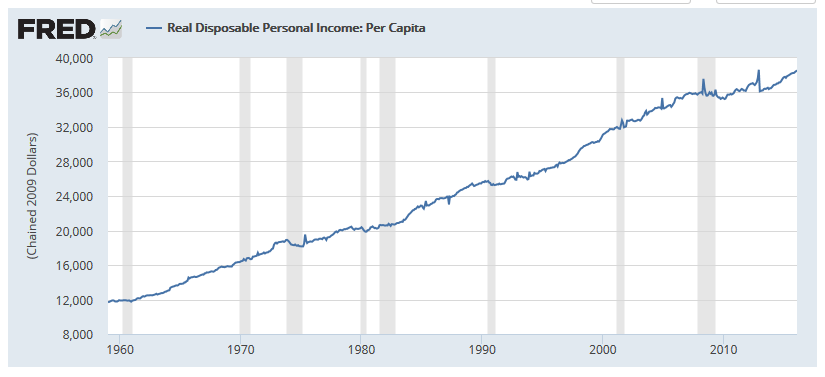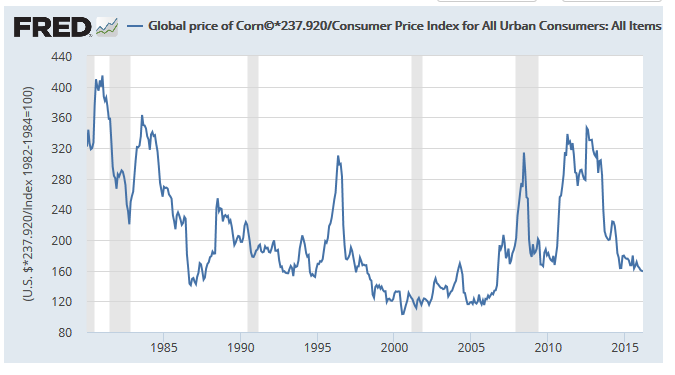Skip to comments.
If anything, globalization increased the cost of meat in America
American Thinker ^
| April 19, 2016
| Sierra Rayne
Posted on 04/19/2016 5:19:56 AM PDT by expat_panama
click here to read article
Navigation: use the links below to view more comments.
first previous 1-20, 21-27 last
To: expat_panama
>> He can’t lose!
Here’s hoping he finds a way. At the primary stage, that is. :-)
21
posted on
04/19/2016 6:54:33 AM PDT
by
Nervous Tick
(There is no "allah" but satan, and mohammed was his demon-possessed tool.)
To: cornfedcowboy
DDG’s limited the cost impact for feedlots, but it’s no coincidence that after beginning a cyclical expansion in 2005, the U.S. cattle population quickly reversed course in 2007 (after peaking at 97 million on Jan 1, of that year) and the next liquidation phase didn’t end until sometime in 2013. Admittedly, drought extended the contraction, but there’s no doubt that a lot of small ranchers and cow-calf operators exited the business, while Midwest grain farmers made out like bandits.
22
posted on
04/19/2016 7:32:09 AM PDT
by
McGarrett
(Book'em Danno)
To: Slambat
...adjust the price of food for inflation but what about... ...income always lags....My bad if I ran w/ too many buzzwords, but up at post #1 my link to real percapita income was the idea that "real" means adjusting for inflation just like we adjusted the price of food for inflation. Also population was covered by "percapita" = per person. Here's the average inflation-corrected American income per person that I linked--

--it's doubled in 30 years. That's why I said it takes half as long to work to feed ourselves now than it did for our parents.
To: expat_panama
http://news.heartland.org/newspaper-article/2013/01/28/study-ethanol-mandates-causing-spiraling-us-food-prices From NPR
Fuel Vs. Food: Ethanol Helps Boost Meat Prices
http://www.npr.org/templates/story/story.php?storyId=132136255
The U.S. corn crop is enormous. But about a third of it doesn't go to cereal or cows — instead, it helps run your car. To boost our use of renewable fuels, the federal government subsidizes corn-based ethanol.
This has the meat and dairy industries up in arms over the high cost of their main feed. The rise of ethanol has pitted livestock producers against the oil industry......
.......But let's get out of the kitchen for a minute — this is a story about corn. Because when you're eating meat, you're indirectly eating lots of corn. Far more corn goes into the meat you're eating than into a box of cornflakes.
.....When it comes to raising meat, eggs and dairy, feed is the biggest cost. And, most likely, that feed is corn.
For years, the livestock industry was the main buyer of cheap and plentiful corn. Then came the ethanol mandate in 2005. Ultimately, the government required that Americans use about 13 billion gallons of ethanol in 2010. And the way we make ethanol here? Yep, you know this one: corn.
To further boost using corn to fuel your car, Congress created subsidies paying gasoline blenders for every gallon they blend with ethanol.
Not surprisingly, since the ethanol mandate was enacted five years ago, the ethanol industry's corn consumption has tripled. Our cars now burn up a third of the nation's corn crop.
“I don't see why we can really justify subsidies, when all that does is raises cost of producing food,” says economics professor Bruce Babcock, of Iowa State University.
Ethanol policies increase the cost of food at least 1.5 percent, Babcock says. And the impact on meat prices is significantly greater.
It's economics 101, he says. Ethanol plants increase the demand for corn, driving up the prices for other buyers — like livestock producers. International demand is up, too – and we're exporting more ethanol than ever before. Many grain farmers are seeing record incomes this year.
24
posted on
04/19/2016 10:30:19 AM PDT
by
Chgogal
(Obama "hung the SEALs out to dry, basically exposed them like a set of dog balls..." CMH)
25
posted on
04/19/2016 12:55:08 PM PDT
by
DoughtyOne
(Hey Ted, why are you taking one for the RNC/GOPe team, and not ours? Not that we don't know.)
To: Chgogal
...economics 101, he says. Ethanol plants increase the demand for corn, driving up the prices... What I'm looking at is that the price of corn has not gone up. In fact, adusted for inflation--

--corn's at the low end of its long term range. This is where the econ prof usually says "your goofy low-corn-price story may be all well and good in practice but in the cold hard world of theory it just falls apart."
To: expat_panama
27
posted on
04/19/2016 6:31:41 PM PDT
by
Chgogal
(Obama "hung the SEALs out to dry, basically exposed them like a set of dog balls..." CMH)
Navigation: use the links below to view more comments.
first previous 1-20, 21-27 last
Disclaimer:
Opinions posted on Free Republic are those of the individual
posters and do not necessarily represent the opinion of Free Republic or its
management. All materials posted herein are protected by copyright law and the
exemption for fair use of copyrighted works.
FreeRepublic.com is powered by software copyright 2000-2008 John Robinson


